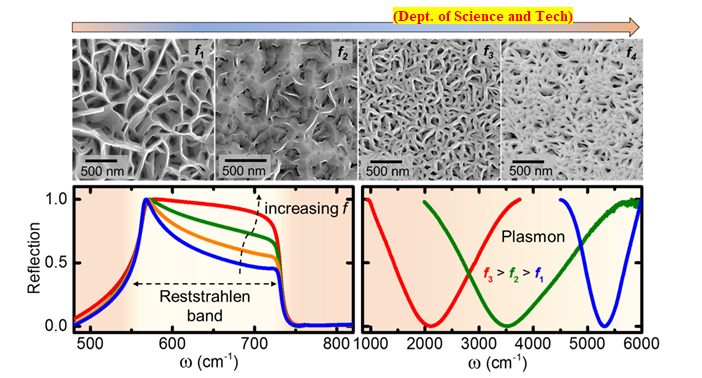New Artificial Nanostructures for Infrared Absorption Technologies can be useful in Defense, Imaging & Sensing (GS Paper 3, Science and Tech)

Why in news?
- Researchers in Bengaluru’s Jawaharlal Nehru Centre for Advanced Scientific Research (JNCASR), have shown for the first time infrared light emission and absorption with GaN nanostructures.
Details:
- Though blue light emission from GaN has been known for some time, and it is used in LEDs, this is the first time that infrared light-matter interactions are demonstrated in GaN.
- For this demonstration, they have utilized a scientific phenomenon called surface polariton excitations in GaN nanostructures that lead to light-matter interactions at IR spectral range.
Background:
- A new method to confine and absorb infrared (IR) light with GaN nanostructures can help develop highly efficient infrared absorbers, emitters, and modulators that are useful in defense technologies, energy technologies, imaging, sensing, and so on.
- GaN, a widely used material for blue light emission, is one of the most advanced semiconductors. Though visible and ultraviolet light applications of GaN have already been realized, with LEDs and laser diodes commercially available, utilization of GaN for IR light harvesting or development of GaN-based IR optical elements is lacking.
Surface polaritons:
- Surface polaritons are special modes of electromagnetic waves traveling at the interface of a conductor and an insulator such as air.
- By altering the morphology and shape of the nanostructures, they are also able to excite plasmon polaritons in GaN, which results in extending the light-matter coupling to further reaches of the electromagnetic spectrum. These polaritons are quasi-particles which have both light and matter characteristics.
Molecular beam epitaxy:
- To grow these GaN nanostructures, the researchers utilized a specialized material deposition instrument called molecular beam epitaxy.
- This instrument uses ultra-high vacuum, similar to the conditions of outer space, to grow high-quality material nanostructures with dimensions about 100000 times smaller than the width of a human hair.
- Such cutting-edge materials allow the creation of polariton-based devices, which offer several advantages to conventional electronic devices.
Applications:
- Polaritonic technologies have attracted a wide range of applications, such as secure high-speed light-based communication (LiFi), next-generation light sources, solar energy converters, quantum computers, and waste-heat converters.
Way Forward:
- This work will greatly benefit in addressing the demand for IR sources and detectors for energy, security, imaging, and other applications.
Railway to modernise 1,000 small stations under Amrit Bharat Station Scheme
(GS Paper 3, Economy)
Why in news?
- The railways is planning to modernise 1,000 small yet important stations under the new ‘Amrit Bharat Station Scheme’.
- This is apart from the ambitious plan to revamp 200 big stations under a separate redevelopment programme.
- The small stations would be identified not just for their footfalls but also based on the cities they cater to.
- The divisional railway managers (DRMs) will take a call on modernisation works in a phased manner. A special fund will also be earmarked with the DRMs for this purpose.

Khurda model of redevelopment:
- The scheme's target is the introduction of new amenities as well as to upgrade and replace existing facilities.
- These stations will be redeveloped under what is being internally called the "Khurda model of redevelopment".
- Khurda station in Odisha was modernised for Rs 4 crore with all contemporary amenities for passengers. The main structure was renovated, the facade was redone and the number of railway tracks was also increased.
How the scheme will be implemented?
- The new scheme envisages cost-efficient improvement to facades and makes provisions for wide, well-lit and aesthetically pleasing entrance porches.
- The DRMs have been instructed to review existing buildings in the station premises and release space for passengers near the entrances and enable relocation of rail offices to other places.
- Creation of new buildings should generally be avoided other than those required for relocation of old structures or relocation of structures to improve circulation or provision of structures to improve the size of waiting halls. Decision on this shall be taken by the DRM.
- Modernisation of these stations would include improved station approaches to ensure smooth access by widening roads, removal of unwanted structures, properly designed signages, dedicated pedestrian pathways, well-planned parking areas, and improved lighting among others.
- The station should also have a second entry station building and high-level platforms with a length of 600m.
Way Forward:
- It aims at preparing master plans of railway stations and implementing those in phases to enhance facilities including and beyond the minimum essential amenities and aim for the creation of roof plazas and city centres at stations.
Scientists freeze Great Barrier Reef coral in world-first trial
(GS Paper 3, Science and Tech)
Why in news?
- Scientists working on Australia’s Great Barrier Reef have successfully trialed a new method for freezing and storing coral larvae they say could eventually help rewild reefs threatened by climate change.

Why it matters?
- Scientists are scrambling to protect coral reefs as rising ocean temperatures destabilise delicate ecosystems.
- The Great Barrier Reef has suffered four bleaching events in the last seven years, including the first-ever bleach during a La Niña phenomenon, which typically brings cooler temperatures.
Cryomesh:
- Cryogenically frozen coral can be stored and later reintroduced to the wild but the current process requires sophisticated equipment including lasers. Scientists say a new lightweight “cryomesh” can be manufactured cheaply and better preserves coral.
- In a December lab trial, the world’s first with Great Barrier Reef coral, scientists used the cryomesh to freeze coral larvae at the Australian Institute of Marine Sciences (AIMS).
- The coral had been collected from the reef for the trial, which coincided with the brief annual spawning window.
- The cryomesh was previously trialled on smaller and larger varieties of the Hawaiian corals.
Mesh technology:
- The mesh technology, which will help store coral larvae at -196°C (-320.8°F), was devised.
- It was first tested on corals.
What is coral bleaching?
- Bleaching happens when corals experience stress in their environment due to changes in temperature, pollution or high levels of ocean acidity.
- Under stressed conditions, the zooxanthellae or food-producing algae living inside coral polyps start producing reactive oxygen species, which are not beneficial to the corals.
- So, the corals expel the colour-giving zooxanthellae from their polyps, which exposes their pale white exoskeleton, giving the corals a bleached appearance. This also ends the symbiotic relationship that helps the corals to survive and grow.
About Great Barrier Reef:
- The reef is located in the Coral Sea (North-East Coast), off the coast of Queensland, Australia.
- It is the world’s most extensive and spectacular coral reef ecosystem composed of over 2,900 individual reefs and 900 islands.
- It was selected as a World Heritage Site in 1981.




